You'll discover seven time-tested methods to preserve fruits and vegetables without refined sugar. Try transforming fresh fruits into chewy fruit leather, fermenting berries with honey and whey, or cooking wild grape jellies using their natural pectin. You can create salt-preserved herb spreads that last for months, slow-cook pectin-free apple butter, or experiment with ancient honey-based fruit preserves. Don't forget traditional root vegetable conserves using nothing but salt and time. These old-world techniques offer healthier alternatives to modern preservation while maintaining authentic flavors. The wisdom of generations awaits in these natural preservation methods.
Traditional Fruit Leather Methods
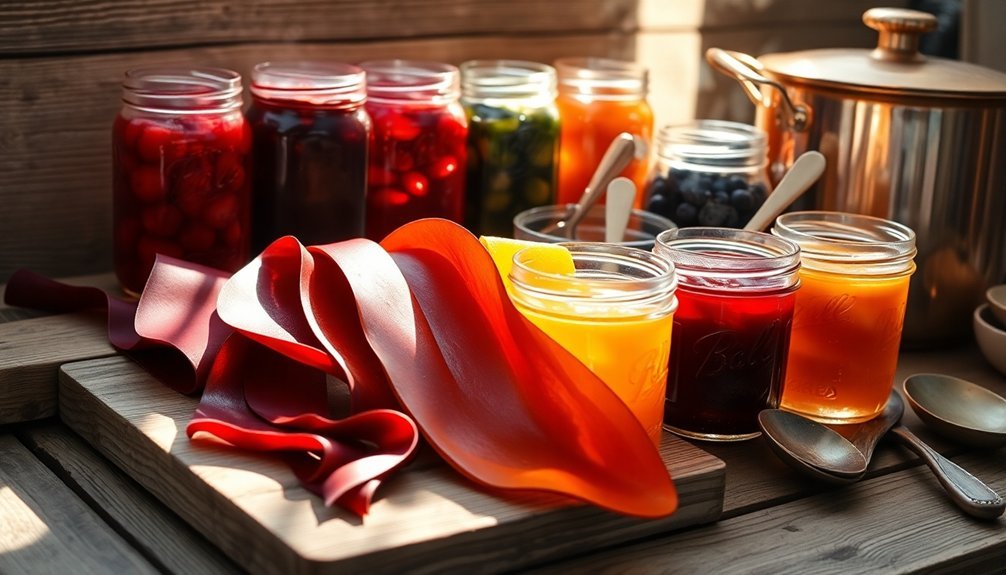
With just a few simple steps, you can transform fresh fruits into delicious, shelf-stable fruit leather using traditional methods.
This versatile recipe allows you to create endless fruit combinations for a customized treat.
Start by thoroughly rinsing your fruits under cool running water, then peel and core them as needed. You'll want to cut most fruits into small pieces, though berries can be left whole. For fruits like apples and peaches, you can keep the skin on if you prefer.
Place your prepared fruits in a saucepan with a small amount of water and cook them over low to medium heat until they're soft.
Once cooled slightly, blend the fruits to your desired consistency – smooth for a uniform texture or pulsed for a chunkier result. You can add a splash of lemon juice to maintain color and enhance flavor.
To dry your fruit leather, line a baking sheet with parchment paper or a silicone mat. Spread the puree evenly at 1/8 to 1/4 inch thickness.
Set your oven to its lowest temperature (around 170°F) and prop the door open. You'll need to dry the leather for 4-6 hours until it's tacky but not wet.
Store your finished leather in airtight containers or vacuum-sealed bags with oxygen absorbers.
Salt-Preserved Herb Spreads
Along with traditional preservation methods, salt-preserved herb spreads offer a delicious way to capture fresh herbs' flavors year-round. You'll want to start with fresh herbs like rosemary, sage, thyme, and basil, using a 4:1 ratio of herbs to salt. Strip away any coarse stems and discolored leaves after washing and thoroughly drying your herbs. This versatile seasoning blend serves as a cost-effective homemade gift when packaged in decorative jars.
For the best results, follow these essential steps:
- Finely chop your herbs and garlic by hand or with a food processor, being careful not to create a paste.
- Mix the chopped herbs with salt and optional ingredients like lemon zest in a large bowl.
- Spread the mixture thinly on baking sheets and dry in a 200°F oven for 20 minutes.
- Store in airtight glass containers, keeping them refrigerated for ideal freshness.
You can use your herb spread immediately or let it develop deeper flavors by storing it in the refrigerator for 7-14 days. The salt acts as a natural preservative, extending shelf life up to 6 months when stored properly.
Remember to shake the container occasionally to maintain even distribution of flavors throughout the mixture.
Fermented Berry Preserves
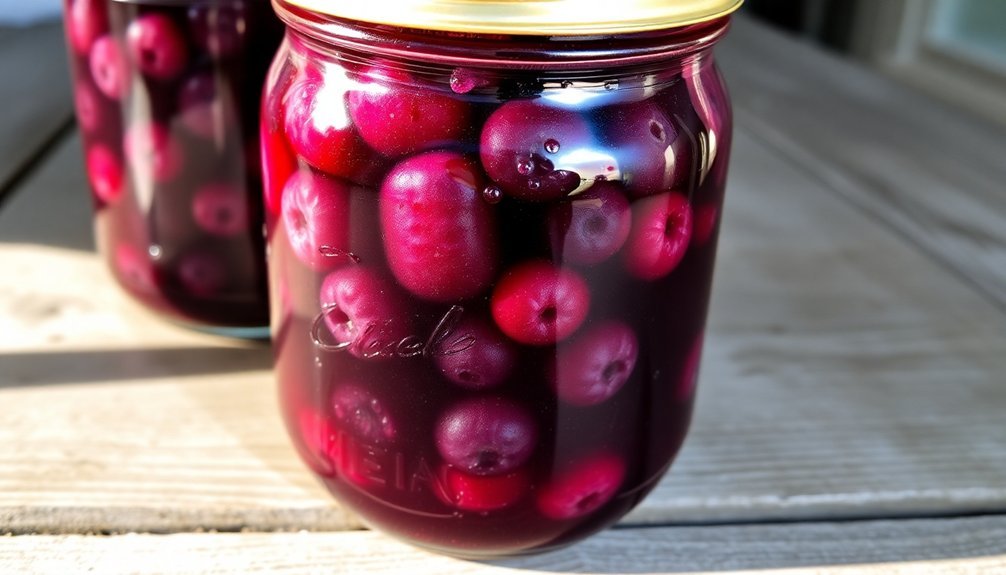
Traditional preservation techniques extend beyond salt-based methods into the fascinating world of fermented berry preserves. You'll find that fermenting blueberries creates a probiotic-rich jam that's both nutritious and long-lasting without requiring processed sugar.
To make fermented blueberry preserves, you'll need fresh blueberries, honey or Sucanat, sea salt, and whey from yogurt or water kefir. This ancient preservation method has been used for centuries of food storage. Start by simmering the berries with sweetener and salt for five minutes, making sure to crush them to release their juices.
Once the mixture cools to room temperature, stir in the whey and transfer everything to clean jam jars. Let your preserves ferment at room temperature for two days, remembering to release excess gases if the jars start to build pressure.
You'll know the fermentation is complete when the jam develops a pleasantly tangy flavor. Transfer the jars to your refrigerator, where they'll keep for several months.
The fermentation process not only preserves your berries but also enhances their nutritional value by producing additional vitamins and beneficial probiotics. You'll notice a complex flavor profile that's distinctly different from traditional sugar-preserved jams.
Pectin-Free Apple Butter
Autumn apples transform into rich, velvety apple butter without the need for added pectin or refined sugar. You'll need 4-6.5 pounds of soft, sweet apples like Golden Delicious, and you can leave the peels on as they'll break down during cooking. Instead of granulated sugar, you can use apple cider or natural sweeteners like sucralose to enhance the natural sweetness.
For the most authentic old-world results, follow these essential steps:
- Place your unpeeled, chopped apples in a slow cooker with your chosen spices (cinnamon, cloves, allspice) and vanilla.
- Cook on low for 10 hours, stirring occasionally for even heat distribution.
- Remove the lid and continue cooking for 2 more hours to achieve proper thickness.
- Blend until smooth using an immersion blender or regular blender.
Once you've reached the desired consistency, test for doneness by spooning the butter onto a plate – it should mound without liquid separation.
Pour the hot mixture into clean jars, leaving ¼-inch headspace, and process in a water bath canner. You can store properly sealed jars in a cool, dark place for extended shelf life.
Wild Grape Natural Jellies
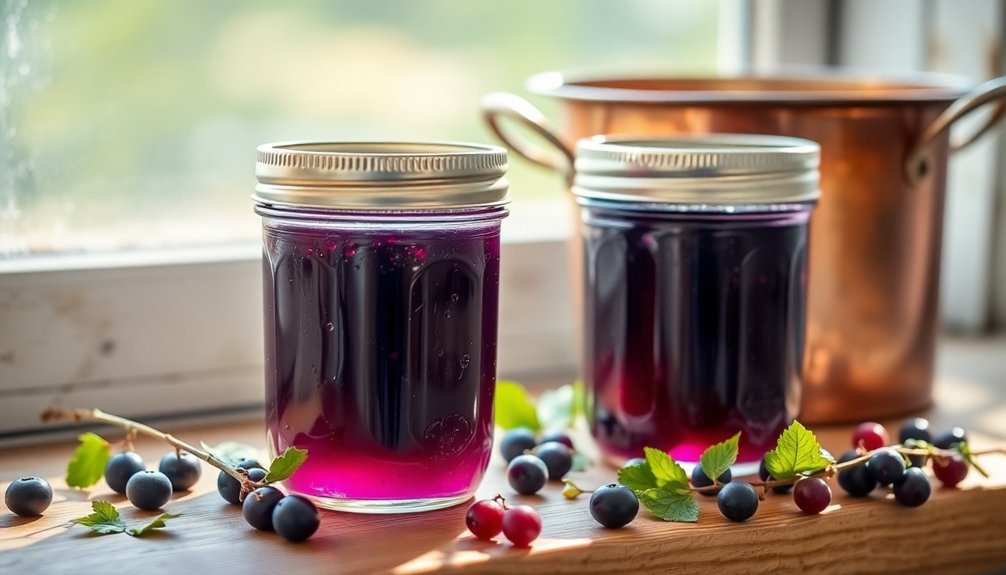
Wild grapes offer a treasure trove of natural sweetness for making old-world jellies without refined sugar. You'll want to harvest these gems around September, focusing on varieties like Vitis riparia, Vitis aestivalis, Fox Grapes, or Oregon Grapes.
Cut whole clusters from the vine using scissors, then wash and remove the grapes from their stems.
To extract the juice, place your cleaned grapes in a Dutch oven with just enough water to cover them by a quarter inch. Bring the mixture to a boil, then use a potato masher to crush the grapes as they cook.
Let them simmer for 30 minutes, then strain through cheesecloth. Don't discard the scraps – you can use them to make wild grape vinegar.
For the jelly-making process, you'll rely on the grapes' natural pectin content. Bring your strained juice to a rolling boil and cook until it reaches 220°F or passes the wrinkle test on a chilled plate.
Pour the mixture into prepared jars, leaving 1/4 inch headspace. Process in a water bath canner for 5-10 minutes. Your natural grape jelly will keep for up to 18 months when properly sealed.
Ancient Honey Fruit Preserves
While wild grapes offer natural sweetness for preserving, honey has been nature's original preservative since the Stone Age. Ancient civilizations, particularly the Greeks, discovered that honey's low moisture content made it perfect for preserving fruits like quince.
You'll find that honey's concentrated sweetness provides more calories per tablespoon than sugar, making it an efficient preservative that maintains fruit's color and texture.
When you're ready to create ancient-style honey preserves, follow these time-tested steps:
- Combine your chosen fruit with honey in a nonreactive pot, adding lemon juice and calcium water for proper acidity.
- Heat the mixture to a low boil, allowing the fruit to break down naturally.
- Mix pectin powder with additional honey, then stir into your fruit mixture.
- Return to a full rolling boil for 1-4 minutes until set.
You'll need to process your preserves in a boiling water bath to guarantee safety.
While this method requires careful attention to heat and acidity stability, you're following preservation techniques that have proven successful for thousands of years. Pre-treating with ascorbic acid helps maintain your fruit's appearance throughout the preservation process.
Root Vegetable Conserves
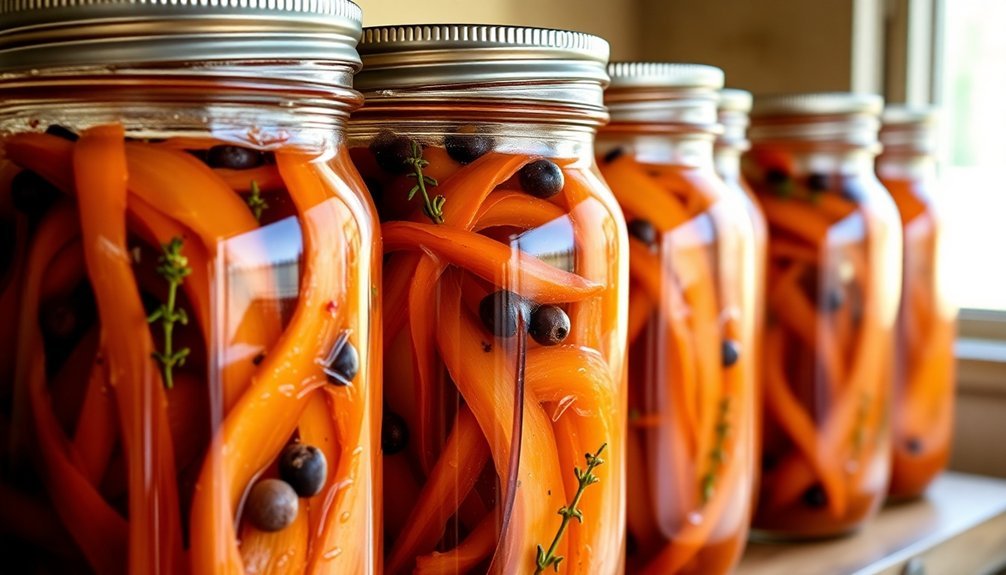
Traditional root vegetable preserving relies heavily on proper preparation and safe canning methods to prevent spoilage. You'll need to start by peeling your root vegetables thoroughly to eliminate bitterness and reduce botulism risks, especially from soil contact. Remove any damaged portions and wash the vegetables meticulously before processing.
| Processing Method | Time Required | Temperature | Safety Notes |
|---|---|---|---|
| Hot Pack | 5 min pre-boil | Boiling | Pre-softens vegetables |
| Raw Pack | No pre-cook | Boiling water | Maintains firmness |
| Pressure Canning | 35-65 min | 240°F+ | Required for non-acidic |
| Pickling | 15-25 min | 212°F | Needs 50% vinegar |
You can choose between raw pack or hot pack methods, depending on your desired texture. For pressure canning, you'll need to adjust processing times based on the specific vegetable and your altitude. If you're pickling, verify your brine contains at least 50% vinegar at 5% acidity, which allows for water bath canning instead of pressure processing. For fermentation, you'll maintain vegetables in salt water at room temperature for 4-6 days, monitoring for bubble formation and checking taste regularly.
Frequently Asked Questions
Can I Reuse Old Canning Lids for No-Sugar Preserves?
You shouldn't reuse old canning lids as they won't create a reliable seal. For safety, always use new lids or invest in reusable alternatives like Tattler or Harvest Guard lids for your canning projects.
How Long Should I Process Jars at High Altitudes?
You'll need to add extra time based on your altitude: 5 minutes at 1,001-3,000 feet, 10 minutes at 3,001-6,000 feet, 15 minutes at 6,001-8,000 feet, and 20 minutes at 8,001-10,000 feet.
What Causes Cloudiness in Sugar-Free Fruit Preserves?
You'll find your preserves cloudy due to under-ripe fruit, improper straining methods, and naturally occurring pectin. Without sugar's preserving properties, these issues become more noticeable. Careful fruit selection and straining are essential.
Which Fruits Naturally Contain Enough Pectin for Preserves?
You'll find apples, crabapples, cranberries, and citrus rinds have the highest natural pectin content. Peaches, apricots, plums, and gooseberries contain moderate levels – they'll work best when they're slightly under-ripe.
Why Do Some No-Sugar Preserves Separate During Storage?
Your preserves separate because alternative sweeteners can't bind water like sugar does. Without sugar's stabilizing effect, you'll notice syneresis – where liquid separates from the gel during storage over time.
In Summary
You've now discovered seven time-tested ways to preserve fruits and vegetables without refined sugar. Whether you're making fruit leather, fermenting berries, or creating honey-based preserves, these old-world techniques let you enjoy seasonal produce year-round while honoring traditional food preservation methods. Try these recipes to connect with ancestral wisdom and create healthier alternatives to modern, sugar-laden preserves for your family's table.

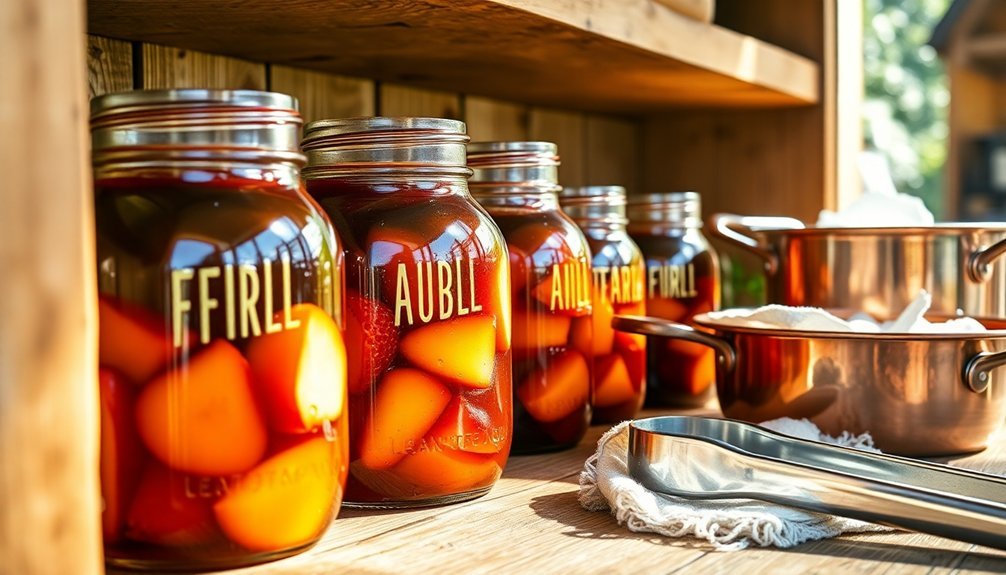



Leave a Reply